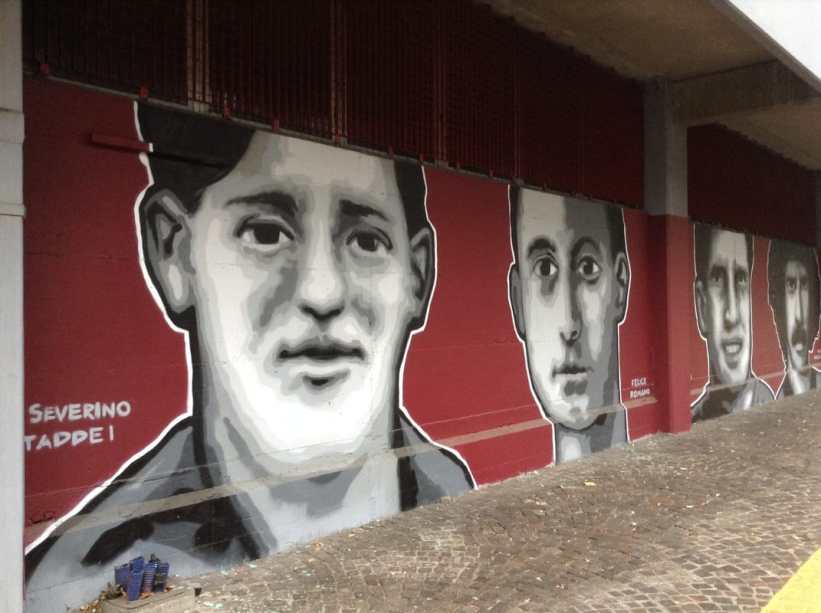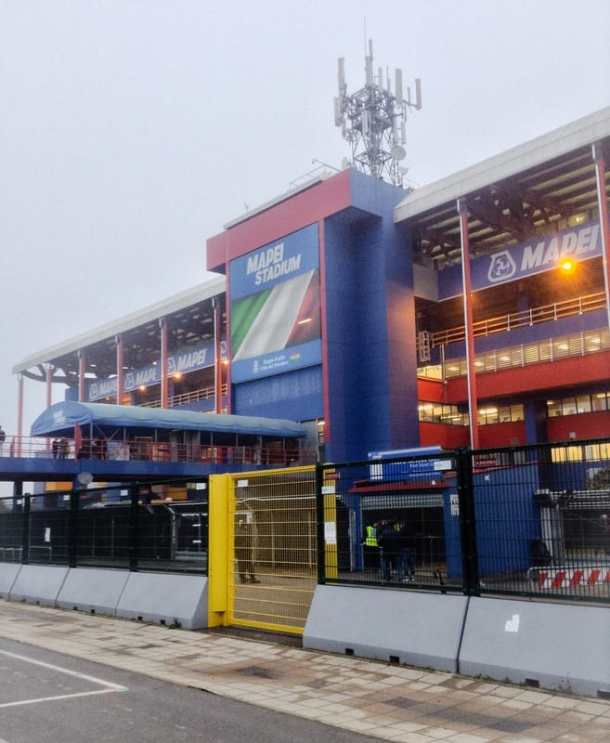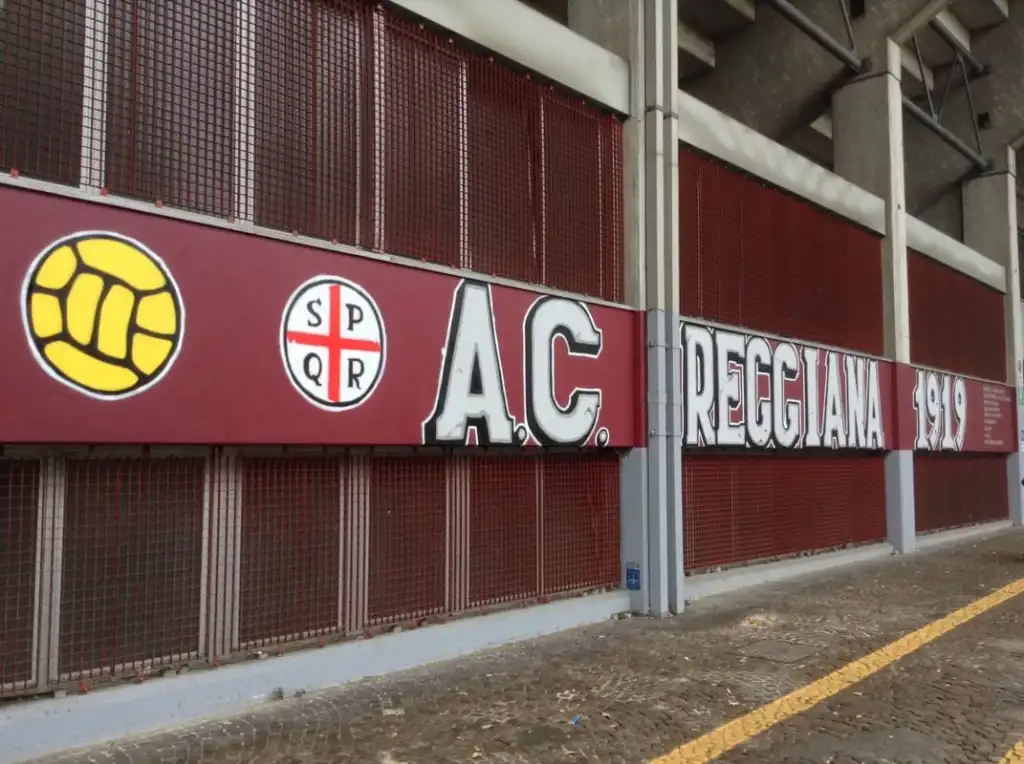“This…we simply cannot accept it,” said one post on a Reggiana fans shared Facebook group. As with many contentious postings on social media platforms, the message was immediately shared amongst a wider audience. A flood of comments in reply soon emerged including emotive statements that this was the “final theft of the Granata temple by another city” and also “the Mirabello is untouchable!” Even more emotive was “Enough, the Mirabello is not an auction item.”
While use of the word ‘theft’ might be little strong, what is true is that for many followers of AC Reggiana the moving in of the Sassuolo Female football team to the Stadio Mirabello (the historic home of AC Reggiana) is a step too far.
As is so often the case, idle words on social media are seldom replicated with actions, especially so when football is being discussed. But on this occasion actions did follow. A call for protest was mobilised in early November (also through Facebook groups) and this would include a meeting by Reggiana fans outside the Stadio Mirabello in protest.
Then, not long before the Serie B Women’s football fixture between Sassuolo and Vittorio Veneto, episodes of vandalism were identified. Nails were maliciously scattered on a playing surface, already not noted for its grass, and the doors of dressing rooms sealed with glue. The latter action was of direct reference to MAPEI, the club sponsors of US Sassuolo. The company’s product range includes adhesives.
Naturally when these activities were discovered, the police and the fire brigade were called, but the game eventually did take place. Since then, investigations have commenced into who put the nails on the pitch and whom exactly might be behind calls for a protest. Likewise, local media outlets have spoken out at the stupid actions of the fans, condemning the nails on the pitch as “ill thought out.”
Reggiana: The Decline
Fans of the traditional Italian club AC Reggiana 1919 have of course been hurting for a number of years. And with the arrival at the MAPEI Stadium of US Sassuolo Calcio the pain has only got worse. Reggiana, a traditional name in the region where football is concerned, have been overshadowed by the new upstarts from a small town near Modena.
Perhaps Reggiana’s decline has its roots in the campaign for a new stadium in Reggio Emilia. These started vocally when Reggiana gained promotion back to Serie A in 1993. Eventually the new Giglio Stadium was opened in 1995 with a sold-out match between Reggiana and Juventus.

On the field, things looked promising for Reggiana at the new stadium. High profile signings like Claudio Taffarel, Paulo Futre, Massimiliano Esposito and Michele Padovano saw some giants of the Italian game defeated and relegation to Serie B was avoided thanks largely to a win at the San Siro.By the time relegation did arrive, Carlo Ancelotti was head coach and under him they again won promotion back to Serie A. However, off the field things were becoming unstable as the club’s main shareholding changed hands. Another high profile coach in Mircea Lucescu was sacked not long into another season by an impatient board of directors
The debt of the new stadium soon started to weigh heavily on the club. Relegation seemed to quickly follow promotion and an ugly pattern emerged despite the likes of Alberigo Evani, Andrea Silenzi, Igor Simutenkov and Angelo Gregucci lining up for Reggiana.
The 1998-99 season should have been the one where their fortunes improved, but economic troubles were impacting morale across all spheres of the sporting institution. A huge squad could not be pruned successfully thanks to a managerial revolving door and the club ended up down in Serie C1.
If finances were fragile before, in the third tier the club started to show the true burden of the debts accumulated. And on the footballing side still the managerial merry-go-round continued at pace.
Relegation to Serie C2 was avoided narrowly for two seasons in a row. But by 2002, Reggiana fans – tired of such disappointing results – erupted in a public protest, filling the most important square of Reggio Emilia and asking for a change in the club’s management and ownership.
However, as the new millennium progressed results did not get any better despite the demands for changes at the top. The club continued to languish in Serie C1 and manager followed manager in and out of the club.
The breaking point came in 2004-05, a season in which Reggiana competed in Serie C1 against the likes of Napoli and reached the play-off rounds for promotion to Serie B.
Around the same time, the most important final games of the season were moved to Cremona due to building work at the Giglio Stadium. But the 8,000 fans who travelled to the city for a play-off game against Avellino were left disappointed, with Avellino eventually winning through.
The real drama then exploded off the field when it was revealed club debts were no longer serviceable. Fans soon mobilised in the centre of Reggio Emilia demanding civic intervention by the mayor to save the city’s professional club, but they eventually folded.
They were forced to start over again in C2 when a consortium emerged out of the dissolution to reform the club. The club badge and legal entity was saved and the club re-established itself as AC Reggiana 1919 SpA.
US Sassuolo: The Rise
If Reggiana were a spent force on the way down the league ladder, by 2005, US Sassuolo were a club well and truly on the up. They reached Serie C1 in 2006 and soon they were proving themselves to be a serious contender for promotion to Serie B. Thanks to sponsorship from MAPEI and astute coaching appointments such as Massimiliano Allegri, Sassuolo were emerging as a club with ambition.
By April 2008, the Neroverdi were a Serie B club, but its humble home stadium at the Stadio Enzo Ricci was clearly unusable for Serie B. Soon a decision was made to move to Modena’s Stadio Alberto Braglia, a location some 17km from the town of Sassuolo.
By the time Sassuolo’s promotion to Serie A was gained for the start of the 2013-2014 season, higher profile football fixtures had already taken place at the home of Reggiana. Carpi had used the Stadio Giglio for some of its home matches during the 2011–12 Serie B season as well as the Stadio Braglia in Modena.
Meanwhile, Reggiana continued to play in their home stadium and had its headquarters relocated to the club and its historical museum located in the Main Stand. But the future of this stadium needed to be resolved. In 2013, the city of Reggio Emilia hosted a public auction and up for grabs were the naming rights for the stadium. The rights were eventually won by ceramic paint and adhesive manufacturer, MAPEI. This was eye opening given the involvement of US Sassuolo Calcio by way of sponsorship since the start of the new millennium.
The stadium was soon renamed the ‘MAPEI Stadium – Città del Tricolore’ due to sponsorship reasons. The ‘Tricolore’ was a reference to the fact that the Italian Tricolour flag had its origins in Reggio Emilia in the year 1797.

Naturally, MAPEI’s acquisition of the stadium’s naming rights provoked a reaction amongst the fans of AC Reggiana. Despite it being Sassuolo Calcio who moved into the stadium and not rivals Parma, many of the club’s followers were angered by the impending presence of a rival club clearly on the rise.Early protests took place including demonstrations at home games and the formation of a group called ‘Via il Sassuolo da Reggio Emilia’ (Sassuolo out of Reggio Emilia). Many queried and highlighted the large distances between the towns of Sassuolo and Reggio Emilia. Organised but peaceful Corteo marches took place through the city centre, geared towards raising attention to the role of Sassuolo at the stadium of Reggiana. On an increasing number of occasions, the topic appeared on social media and, in September 2016, Luca Vecchi, the Mayor of Reggio Emilia, was heavily booed by the Reggiana fans during an appearance at the stadium.
Just who owns the MAPEI Stadium is an area of debate amongst many Reggiana fans who still, despite the financial carnage of 2005, see the stadium as belonging to them.
Management of the stadium day-to-day is still said to be with AC Reggiana, and Sassuolo rent for football playing purposes. However, MAPEI have embarked upon a vast project of modernisation with various interventions concerning the playing field occurring. The most significant has been the mass branding of the stadium with the ‘MAPEI’ sponsor logo including the tall floodlights.
For Reggiana’s fans, the stadium has been turned into a landmark for MAPEI and likewise Sassuolo. And, while the green and black colours of Sassuolo do not dominate the corporate feel or interior, the core fan groups of Reggiana feel somewhat marginalised. One area of the ground – the Curva Sud – continues to be the dedicated home end for Reggiana fans, but the artwork dedicated to the club is minimal and only for ‘token appeasement.’
Beyond the objections of the Reggiana fan groups, the civic city of Reggio Emilia sees the MAPEI as having the sole objective of representing a cosy and functional mutual home for two clubs. Politicians within the region have stated the aim of making the ground a landmark for the whole football movement of the region.
On a cold damp Saturday afternoon in late November 2016, I headed up to Reggio Emilia from Bologna to see what the fans of Reggiana really thought. In anticipation of a Lega Pro match being played that afternoon between AC Reggiana and AlbinoLeffe, hundreds were congregating in the nearby bar outside the stadium where spirits were high.
Outside the ground before kick-off I met Stefano, a season card holder at Reggiana and a fan of the club for over 25 years. According to him, today’s opponents AlbinoLeffe are a “plastic club…just like Sassuolo.” But his main gripes are reserved for Parma, who Reggiana will soon play again in the Derby dell’Emilia. “At least”, Stefano says pointing to the floodlights, “we don’t share this place with Parma.”
Inside the ground there are one or two chants about Sassuolo but noticeably, at least in the Reggiana end, very little in the way of the Sassuolo club logo. The stickering (always a good indicator of local fan culture) is almost wholly dedicated to Reggiana despite the current 2016-17 season seeing UEFA Europa League football at the MAPEI.
Reggiana beat AlbinoLeffe 2-0 and the next morning I decided to adventure to the Stadio Mirabello, which sits not far from the main railway station in Reggio Emilia. Opened in 1912, the Mirabello held in its heyday 17,000 people and outside the stadium there is a memorial to some supporters of Juventus who died at Heysel.
But on the outer façades of the stadium there exists an even more poignant reminder that the Mirabello is the true spiritual home of Reggiana. The front of the stadium has a range of colourful murals dedicated to the club logo, name, as well as an array of murals dedicated to past playing legends. The scene is all the evidence a visitor needs that this location is the historic home of the Granata.
With the decline of Reggiana and the moving in of MAPEI and Sassuolo, the Mirabello Stadio has a sacred place in both the minds and hearts of Reggiana fans.
Despite playing host to the rugby matches of local sides Rugby Reggio and Zebre Parma, its use and symbolic value to the club continue to be very sensitive. This is especially true with respect to the hard-core elements of the Reggiana support.

So while many have reconciled themselves to the newer status of the MAPEI, news of the appearance of the Sassuolo female football team at the Mirabello is a step too far and for some has occurred under the radar of Granata supporters. For its part, US Sassuolo have made a move to the Mirabello official. They state on their official website that its female team now have football residency there for the purpose of women’s Serie B fixtures.For the sports administrators in the city, namely The Sports Section of the Foundation of the Municipality of Reggio Emilia, the “Mirabello question” is one of proactive responsibility to the wider Reggio Emilia community.
Needless to say they have not engaged in a social media war and instead have left the vandalism activities at the Mirabello to the police and (in the case of the glued door) the emergency services.
Political intervention and courtroom legal arguments have formed a backdrop to the emotive online supporter bickering and protest mobilisation. The Rugby teams, for all the influence they have (many of whom once played at the Mirabello), queried why a female football team can use the stadium while they no longer can.
Meanwhile in response, local counsellors have suggested that not making the ground available to the female Sassuolo players could be regarded as discriminatory. “The operation of the Mirabello,” said one local politician, “should be conducive to cooperation between institutions and sports clubs and all obstacles should be removed.”
While the Mirabello affair has not really come to overshadow the sporting endeavours of the female footballers, the organic presence of a Sassuolo team and the MAPEI brand at the Mirabello is a tough blow to take for Reggiana fans.
Little hard feeling or sense of revenge was ever really expressed against the Rugby Reggio team who used the Mirabello. But the appearance of the Sassuolo Ladies team (however minimal) is clearly one that has reignited feelings of belonging, history and tradition.
Words by Damon Main @TheAwaySection
Founder of www.theawaysection.com Damon is currently based in Scotland. From his first football match in 1978 to more recent times, Damon somehow still manages to combine his sense of wanderlust with a camera and laptop.

